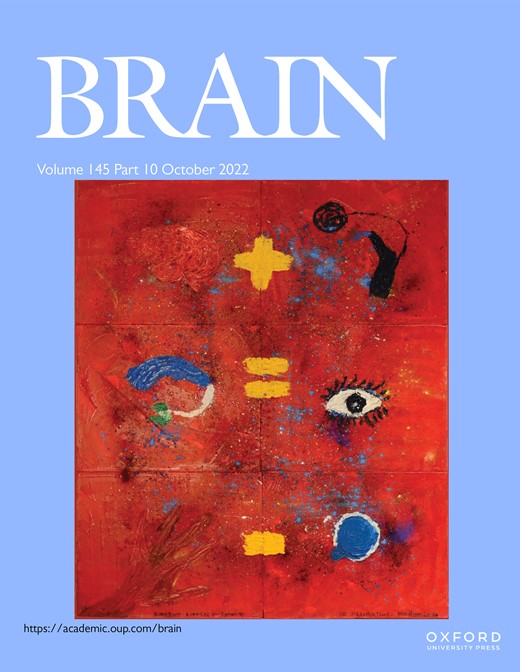
Cover image

Volume 145, Issue 10, October 2022
Editorial
Risk aversion keeps universities safe and effective. Discuss
Essay
Cranial trepanation in pre-Columbian Peruvian cultures: was it an option to treat epilepsy?
Cranial trepanation is the oldest known surgical procedure in the world, but why was it performed? By examining evidence from pre-Columbian Peruvian cultures—where trepanation was relatively common—Espino et al. critically evaluate whether trepanation was used as a treatment for epilepsy.
Scientific Commentaries
Seronegative autoimmune encephalitis: exploring the unknown
This scientific commentary refers to ‘Seronegative autoimmune encephalitis: clinical characteristics and factors associated with outcomes’ by Lee et al. (https://doi.org/10.1093/brain/awac166).
Sex differences in Alzheimer’s disease risk: are immune responses the key?
This scientific commentary refers to ‘Sex-specific effects of microglial activation on Alzheimer’s disease proteinopathy in older adults’, by Casaletto et al. (https://doi.org/10.1093/brain/awac257).
Loss of PTEN phosphorylation via single point mutation alters cortical connectivity and behaviour
This scientific commentary refers to ‘The impact of phosphorylated PTEN at threonine 366 on cortical connectivity and behaviour’ by Ledderose et al. (https://doi.org/10.1093/brain/awac188).
Exciting insights into tumour-associated epilepsy with electrophysiological and optical recording
This scientific commentary refers to ‘Single unit analysis and wide-field imaging reveal alterations in excitatory and inhibitory neurons in glioma’ by Gill et al. (https://doi.org/10.1093/brain/awac168).
Review Articles
Towards network-guided neuromodulation for epilepsy
Piper et al. describe the current state of network-guided neuromodulation for epilepsy and speculate on future directions. They review the mechanisms by which intracranial neurostimulation therapies reduce the frequency and severity of seizures and examine the neural networks underpinning current stimulation targets.
Contribution of B cells to cortical damage in multiple sclerosis
Bhargava et al. review the role that B cells play in mediating cortical demyelination and neuronal damage. They review evidence linking B cells to cortical injury, potential mechanisms by which B cells may mediate oligodendrocyte and neuronal death and treatment strategies that could be used to target pathogenic B cells.
Reports
Recurrent de novo mutations in CLDN5 induce an anion-selective blood–brain barrier and alternating hemiplegia
Hashimoto et al. identify a novel de novo mutation in the gene encoding claudin-5 in two unrelated cases of alternating hemiplegia of childhood. The mutation converts tight junctions containing claudin-5 to anion-selective channels, thereby turning part of the blood–brain barrier into a blood–brain channel.
Endocannabinoid dysfunction in neurological disease: neuro-ocular DAGLA-related syndrome
Bainbridge et al. show that mutation of the endocannabinoid gene DAGLA causes a paediatric syndrome with developmental delay, ataxia and abnormal head and eye movements. DAGLA activity is preserved in affected individuals, suggesting that mislocalization of the truncated protein may account for the observed phenotype.
Clinical Trial
Self-modulation of motor cortex activity after stroke: a randomized controlled trial
In a randomized sham-controlled trial, Sanders et al. show that chronic stroke survivors with hemiplegia are able to use real-time functional MRI neurofeedback to self-modulate motor cortex activity, resulting in improvements in gross motor performance of the affected limb and structural brain changes.
Original Articles
Double administration of self-complementary AAV9NDUFS4 prevents Leigh disease in Ndufs4−/− mice
Corrà et al. show that double administration of a self-complementary-adeno-associated viral 9 vector expressing human NDUFS4, via intra-vascular and intra-cerebroventricular injections on P1, prevents the onset of Leigh-like disease in Ndufs4−/− mice. The intervention extends healthy lifespan by several months compared to untreated mice.
CHCHD10 and SLP2 control the stability of the PHB complex: a key factor for motor neuron viability
Genin et al. show that the mitochondrial proteins SLP2 and prohibitins are part of the pathological cascade through which the p.Ser59Leu variant of CHCHD10 gives rise to ALS. Aggregates of SLP2/prohibitins and instability of the PHB complex in the inner mitochondrial membrane lead to mitochondrial fragmentation and cell death.
Characteristics, surgical outcomes, and influential factors of epilepsy in Sturge-Weber syndrome
Wang et al. report that epilepsy surgery results in good seizure and cognitive outcomes and shows acceptable safety for patients with epilepsy in Sturge-Weber syndrome. Early surgery may be helpful in achieving better seizure outcomes and cognitive protection, although the risks should also be considered.
A Mendelian randomization study investigating the causal role of inflammation on Parkinson’s disease
Bottigliengo et al. investigate the causal relationship between inflammation and Parkinson’s disease using a two-sample Mendelian randomization design. They show that higher IL-6 levels are associated with younger age at onset of Parkinson's disease, suggesting that elevated IL-6 levels could be part of the disease prodrome.
Tau accelerates α-synuclein aggregation and spreading in Parkinson’s disease
Tau deposits are common in the brains of patients with Parkinson’s disease; however, the role of tau in the disorder remains unclear. Pan et al. demonstrate that tau binds α-synuclein and promotes its aggregation, contributing to the onset of Parkinson’s disease.
Lipid pathway dysfunction is prevalent in patients with Parkinson’s disease
Galper et al. use an unbiased lipidomic approach to quantify thousands of lipids in serum and CSF from two large Parkinson’s disease cohorts. The results reveal altered lipid profiles that converge on major metabolic pathways, providing new insights into the extent of lipid dysfunction in Parkinson’s disease.
Amphetamine-induced dopamine release and impulsivity in Parkinson’s disease
Song et al. report that reward-based behaviours in Parkinson’s disease are regulated by ventral striatal dopamine release, and propose that loss of inhibitory feedback from midbrain autoreceptors may predispose a subset of patients to developing impulsive and compulsive behaviours.
Mild motor impairment as prodromal state in amyotrophic lateral sclerosis: a new diagnostic entity
Having observed ALS phenoconversion in 20 pre-symptomatic gene mutation carriers, Benatar et al. conclude that a prodromal period of mild motor impairment (MMI) precedes many (if not most) forms of ALS. They highlight the implications for reducing diagnostic delay and for early therapeutic intervention.
Seronegative autoimmune encephalitis: clinical characteristics and factors associated with outcomes
Lee et al. examine clinical characteristics and disease course, effectiveness of immunotherapy and prognostic factors in patients with seronegative autoimmune encephalitis. Combination immunotherapy with steroids, immunoglobulin, rituximab and tocilizumab was associated with improved outcomes.
See van Steenhoven and Titulaer (https://doi.org/10.1093/brain/awac338) for a scientific commentary on this article.
Linking lesions in sensorimotor cortex to contralateral hand function in multiple sclerosis: a 7 T MRI study
Madsen et al. show that patients with multiple sclerosis with cortical lesions in the sensorimotor hand area (visible on 7 T MRI) have reduced sensorimotor hand function and reduced corticomotor output. These results indicate that cortical lesions lead to domain-specific functional impairment and local cortical dysfunction.
Sex-specific effects of microglial activation on Alzheimer’s disease proteinopathy in older adults
Using counterfactual causal inference models with human neuropathological data, Casaletto and Nichols et al. find that microglial activation mediates the relationship between amyloid-β and tau burden in females but not males. Microglial activation may be relatively more important for Alzheimer’s disease pathogenesis in females.
See Buckley (https://doi.org/10.1093/brain/awac316) for a scientific commentary on this article.
Ante-mortem plasma phosphorylated tau (181) predicts Alzheimer’s disease neuropathology and regional tau at autopsy
In one of the largest studies of its kind, Morrison et al. show that ante-mortem plasma phosphorylated-tau181 concentrations accurately differentiate brain donors with and without autopsy-confirmed Alzheimer‘s disease. Blood tests could be a minimally invasive, cost-effective tool for the detection and monitoring of Alzheimer’s disease.
Seeding, maturation and propagation of amyloid β-peptide aggregates in Alzheimer’s disease
Li et al. identify molecular features of amyloid plaques that affect their propagation and consolidation in the brain. Taking these factors into account when developing amyloid-targeting therapies could pave the way to better outcomes for patients with Alzheimer’s disease.
Genetically identical twins show comparable tau PET load and spatial distribution
Coomans et al. reveal substantial similarities in tau load and spatial distribution in identical twins, and show that they can identify pairs of twins based on tau spatial distribution. However, within-pair differences—particularly in tau load—also suggest a role for (modifiable) environmental factors in tau accumulation.
APOE4 derived from astrocytes leads to blood–brain barrier impairment
Jackson et al. demonstrate that allele-specific knock-in mice expressing humanized APOE ε4, but not APOE ε2 or ε3, show a leaky blood–brain barrier with impaired tight junctions and reduced astrocyte endfoot coverage of blood vessels. Removal of astrocyte-produced APOE ε4 restores normal blood–brain barrier function.
Autosomal dominant and sporadic late onset Alzheimer's disease share a common in vivo pathophysiology
The extent to which the pathophysiology of autosomal dominant Alzheimer’s disease corresponds to that of late onset Alzheimer’s disease is unclear. Morris et al. reveal similar rates of change of biomarkers in individuals with each disease type, suggesting that the two disorders share a common pathophysiology.
The impact of phosphorylated PTEN at threonine 366 on cortical connectivity and behaviour
PTEN is a key regulator of neuronal signalling, and PTEN mutations have been identified in patients with autism spectrum disorders. Using a newly generated knock-in mouse, Ledderose et al. show that phosphorylation of PTEN at threonine 366 controls neuron size and connectivity of brain circuits involved in sensory processing.
See Binder and Bordey (https://doi.org/10.1093/brain/awac350) for a scientific commentary on this article.
Alpha-synuclein supports type 1 interferon signalling in neurons and brain tissue
The normal function of alpha-synuclein in neurons is not clearly defined. Monogue et al. show that alpha-synuclein functions in neurons to support immune signalling. Following interferon stimulation, alpha-synuclein co-localizes to the nucleus with interferon signalling proteins to support neuronal expression of interferon-regulated genes.
Nav1.7 is required for normal C-low threshold mechanoreceptor function in humans and mice
Middleton, Perini et al. show that the role of Nav1.7 extends beyond pain perception. Using a multidisciplinary, cross-species approach, they show that Nav1.7 is also essential for C-low threshold mechanoreceptor function in mice and humans, regulating pleasant touch, punctate discrimination and sensitivity to cooling.
Regional healthy brain activity, glioma occurrence and symptomatology
Numan et al. report that gliomas occur more frequently in brain regions that are characterized by intrinsically higher activity levels, as measured in healthy people. Moreover, intrinsic brain activity at individual tumour locations relates to tumour biology and patients’ functional status.
Single unit analysis and wide-field imaging reveal alterations in excitatory and inhibitory neurons in glioma
By combining microelectrode array recordings with wide-field optical mapping of Thy1-GCaMP pyramidal cells in glioma, Gill et al. reveal alterations in the relationship between excitatory and inhibitory neurons. mTOR inhibition reversed these changes, suggesting that peritumoural neuronal interactions can be modulated.
See French (https://doi.org/10.1093/brain/awac351) for a scientific commentary on this article.
Stimulation of the cuneiform nucleus enables training and boosts recovery after spinal cord injury
Hofer et al. show that deep brain stimulation of the cuneiform nucleus of the mesencephalic locomotor region is safe, enables high-intensity step training and improves long-term recovery of gait after severe incomplete spinal cord injury in rats.
Sensory experience modulates the reorganization of auditory regions for executive processing
Using functional MRI, Manini, Vinogradova et al. show that the auditory cortex of deaf individuals is involved in task switching. These findings show that sensory cortices can change their function to higher-order cognition, and that sensory experience shapes cortical reorganization and executive processing in the brain.
Biallelic variants in SLC35B2 cause a novel chondrodysplasia with hypomyelinating leukodystrophy
Guasto et al. report that SLC35B2 functional impairment causes a novel syndromic chondrodysplasia with hypomyelinating leukodystrophy, most likely through a proteoglycan sulphation defect. This is the first time that SLC35B2 variants have been associated with bone and brain development in humans.
































